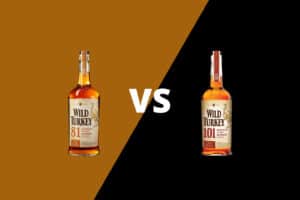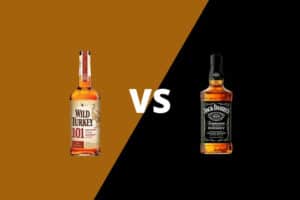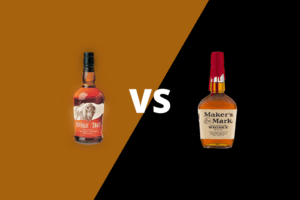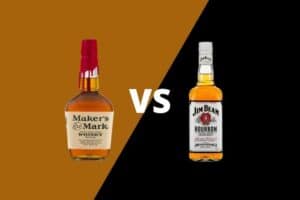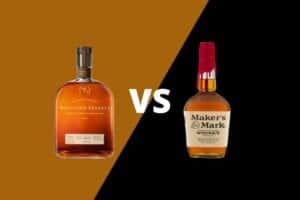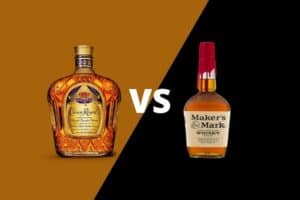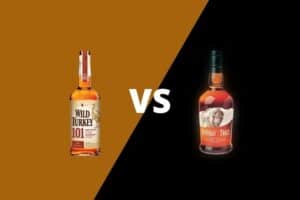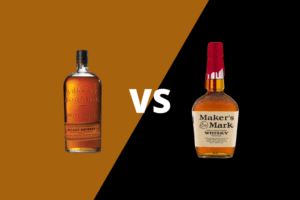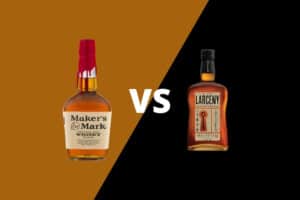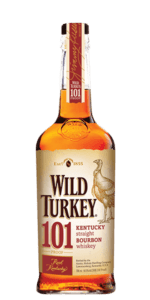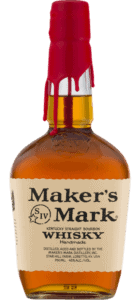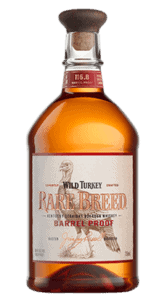We stand on the backs of giants.
This matchup pits a protector of the pre-prohibition, high rye, bonded whiskey-making style against a pioneer in the wheated premium bourbon segment. Each has been led by Bourbon Hall of Famers and has had decades of influence over what the bourbon community considers a quality bourbon.
As you’ll see in this post, there are passionate adherents on both sides of this divide. We’ll compare and contrast these two successful brands so that you’re fully armed if asked to weigh in on the debate.
Whiskey fans — let your preference be known!
Table of Contents
History
The brand recognition these two brands enjoy is partly because they’ve been household names since the middle of the 20th century.
The Austin Nichols company was a wholesaler based in Tyrone, Kentucky, that began operation in the 1800s. Following the repeal of Prohibition in the 1930s, the Austin Nichols company bottled several brands as a non-distiller producer — or NDP.
The Wild Turkey name came about from some barrel samples on a turkey shoot. During a turkey hunt in 1940, an executive shared the samples with his friends — who continued to hound him for more of that ‘wild turkey bourbon.’ The brand was launched two years later.
In 1954 Wild Turkey hired Jimmy Russell, who would become Master Distiller of the brand and continue to work with the brand to this day. Austin Nichols purchased the Boulevard Distillery in 1971, which was renamed the Wild Turkey Distillery. About a decade later, Austin Nichols was acquired by French drinks group Pernod Ricard and then purchased by Italian drinks maker Campari Group.
Here we’ll note Wild Turkey Master Distiller Jimmy Russell and the man who founded Maker’s Mark — Bill Samuels, Sr. — were industry contemporaries. In fact, the same year Jimmy Russell was hired, Bill Samuel’s, Sr., purchased the old Burk’s Distillery and began his journey to put his mark on the industry. The contributions they have made to the bourbon world cannot be overstated, and it should not be surprising that both have been inducted into the Bourbon Hall of Fame.
Jimmy’s high-rye mash bill, 101-proof and stellar value were a nod to the bottled-in-bond style pioneered in the 19th century. But Bill Samuels’ wheated mash bill and premiumized product packaging and pricing were a glimpse into the future.
The Maker’s Mark brand was launched by the Samuels family in 1958. Legend — and brand marketing copy — has it Margie Samuels had a bake-off to discover the mash bill. We certainly don’t want to take away from the contributions of Margie Samuels, who, along with her husband Bill, launched one of America’s great bourbon brands. After all, she has been given full credit for the globally recognized square bottle, craft packaging and red wax seal and was the first woman to be inducted into the Bourbon Hall of Fame.
But industry insiders tell a more nuanced story that included a conversation between Bill and yet another Bourbon Hall-of-Famer.
According to this narrative, Bill Samuels, Sr., and Julian P. ‘Pappy’ Van Winkle were close friends. For decades, Van Winkle had pioneered the wheated bourbon flavor profile at his Stitzel-Weller Distillery — most notably with the Weller and Old Fitzgerald brands.
We’ll let whiskey expert Chuck Cowdery recount the story from there:
Bill told Pappy he was planning to start up the old distillery that became Maker’s Mark. Pappy supposedly gave him the Old Fitz recipe and said, “make this and charge an arm and a leg for it. You won’t bother me because that’s not my business.”
Maker’s Mark leaned into this messaging. Their launch campaign brought attention to the high price-point as a unique product attribute. This was an ahead-of-its-time example of the practice that today is known as ‘premiumization.’ It is remarkable when you consider that during the post-war period when Maker’s Mark launched, many bourbon makers were in a race to the bottom, working to offer the highest age statement whiskey at the lowest price.
Today, Maker’s Mark is considered a pioneer on many fronts. They should be given credit for introducing the idea of wheated bourbon to a nation-wide audience, embracing the hand-crafted aspect of their product to help elevate the bourbon category, blazing a path in marketing and packaging and offering one of the first examples of a small family-owned craft distillery in the United States.
Mashbills
Soft, red winter wheat vs. high-rye.
According to U.S. regulations, bourbon is required to have a mash bill — or list of grain ingredients — that include at least 51 percent corn. But the two distillers who molded these brands have distinctly different approaches to whiskey that help highlight the diversity within the bourbon category.
First, let’s consider Wild Turkey. Master Distiller Jimmy Russell takes an old-school approach to bourbon. Wild Turkey has 75 percent corn, 13 percent rye and 12 percent malted barley. While this might be considered a ‘traditional bourbon grain bill,’ to many distillers, the high-rye packaging you may find on a bottle of Wild Turkey shows the brand’s dedication to highlighting the spicy pepper notes of rye grain in the finished product. Throughout the world, this bold spice note is considered a distinctly American flavor, one that helps differentiate bourbon from other global whiskey expressions like scotch and Irish whiskey.
Next, let’s look at Maker’s Mark, which uses soft, red winter wheat in the mash bill. When creating the mash bill for this brand, Bill Sr. and Margie Samuels discarded the traditional rye grain and substituted it with wheat, which offers soft and sweet notes, and gives the product a more rounded mouthfeel and flavor. As a result, the Maker’s Mark mash bill contains 70 percent corn, 16 percent wheat and 14 percent malted barley.
Wheat is awfully familiar to scotch makers, and you are likely to find wheat-based flavoring whiskeys as a component in most blended scotch and Irish whiskeys. As a result, Maker’s Mark is a natural gateway between the two product categories — which is a reason it continues to be a favorite among scotch drinkers, new bourbon drinkers and seasoned bourbon aficionados alike.
This matchup is the perfect opportunity to learn more about secondary or flavoring grains. Both have the corn sweetness inherent in the bourbon category but use varying secondary grains to give each product a distinctly different flavor.
Distillation & Production
Both Maker’s Mark and Wild Turkey are made in modern, high-capacity distillation facilities in Kentucky. They both use reflux column distillation for bourbon production.
The Maker’s Mark Star Hill Distillery is in Loretto, while Wild Turkey is about 50 miles away in Lawrenceburg. Both facilities have about the same distilling capacity.
Maturation
Neither Maker’s Mark nor Wild Turkey has an age statement.
Maker’s Mark has stated in marketing material and media that their maturation profile is about six years. And for decades, Wild Turkey was offered with an eight-year age statement. While the label lost the age statement in 1992, Jimmy Russell and his production team have gone to a great length to keep the same flavor profile.
One distinctive feature of the Maker’s Mark maturation regimen is the use of Scotland-style dunnage warehousing. Traditionally, these single-storied buildings are the preferred method of maturation for single-malt producers in Scotland. Their stone cellars help maintain temperature, humidity and barometric pressure conditions within the warehouse.
Contrast these with the traditional seven-storied wooden rickhouses in Kentucky. Micro-climate conditions vary significantly between the various floors within these rack houses, leading to ‘sweet spots’ within each warehouse that blenders often utilize to create distinct products or single-barrel offerings.
Ownership
Maker’s Mark is produced by Japan-based Beam Suntory.
Wild Turkey is produced by Italian drinks maker Gruppo Campari.
Price Point & Value
Wild Turkey 101-proof retails for about $25 for a 750mL bottle.
Maker’s Mark retails for about $30 for a 750mL bottle at 90-proof.
When comparing these two brands, it is essential to consider that Wild Turkey is in the standard pricing segment while Maker’s Mark is a premium product.
Tasting Notes
Maker’s Mark Kentucky Straight Bourbon Whisky
Nose: New oak and cherry aromas, with honey, soft wheat and malted cereal notes.
Palate: Sweet honey, vanilla, maple syrup and almond flavors.
Finish: Lingering maraschino cherry, chocolate, clove and baking spices.
[Related: Complete Maker’s Mark Bourbon Review]
Wild Turkey 101-proof Kentucky Straight Bourbon Whiskey
Description: In the glass, Wild Turkey has a red-brown auburn color, with incredible legs at 101-proof.
Nose: The aromas of caramel and new oak, with toffee, chocolate and honey, with notes of leather and tobacco.
Palate: Corn sweetness with honey, vanilla, cinnamon and baking spices flavors, with notes of cherry, tobacco and leather.
Finish: Black pepper spice, with lingering tobacco, leather and a hint of maple syrup.
[Related: Complete Wild Turkey 101 Bourbon Review]
Verdict…
So, who comes out on top?
When comparing these two brands side-by-side, there are a few things to consider.
The first is the price segment. Wild Turkey is considered to be in the standard pricing tier — alongside other bourbon brands like Evan Williams, Jim Beam, Buffalo Trace and Elijah Craig. You’ll notice when comparing Wild Turkey alongside these other high-volume brands that its delicious honey and rye spice notes shine even at its stronger 101-proof. Against these competitors, Wild Turkey’s flavor profile offers exceptional bang-for-buck.
Maker’s Mark’s price puts it in the premium pricing category alongside brands like Knob Creek, Jim Beam’s black label and single barrel expressions, Wild Turkey’s portfolio-mate Russell’s Reserve and Evan Williams Single Barrel. Against these competitors, the smooth and mellow characteristic gives it unique positioning in the marketplace.
Next, you must consider personal preference. The high-rye Wild Turkey approach is excellent for bourbon lovers, those well versed in barrel proof American whiskey and Rye whiskey fanatics. Maker’s Mark, on the other hand, is perfect for the newcomer to the American whiskey category or for those who favor scotch to bourbon. It’s the perfect brand to challenge someone who ‘doesn’t like bourbon’ to expand their horizons.
As a learning tool, lining up glasses of these bourbons side-by-side offers an excellent example of high-rye vs. wheated bourbon for a unique tasting experience.














